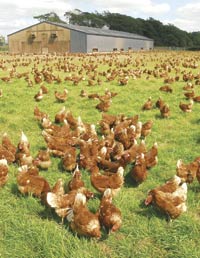Poultry breeder predicts continuing layer improvement

Egg producers have seen huge benefits from breeding, with Hy-Line breeders achieving an average improvement of 3.6 more eggs per hen housed and 26g less feed needed to produce 1kg of egg per generation over the last 25 years.
These improvements are crucial, since feed cost and the birds’ efficiency in converting it into eggs are the most important components driving the economics of commercial layer businesses.
Feeding practices and feed ingredients vary tremendously throughout the world, as well as within different regions of a given country. On the other hand, feed intake can vary not only according to the ingredients in the diet, but also due to management and environmental conditions, including type of housing, climate and feeding practices.
However, one thing is constant; feed cost alone accounts for most of the total production cost of egg production, ranging from 50-60% depending on the country and production system.
By having a particular emphasis on feed intake and feed efficiency, we can ensure that selection for improved feed efficiency is accomplished with each generation of commercial chicks placed in the field. Also it ensures that improvements in performance and feed efficiency lead to better profitability for commercial producers, without any negative effects on the birds or environment.
Our ultimate goal is to produce more efficient birds in each generation, which survive and adapt well, grow well, are healthy and perform at an optimal level without consuming excess feed. To be successful in such an approach, many traits (see box right have to be considered simultaneously during the selection programme.
The practical implementation of such a programme requires the use of three different types of data. First, there is pedigree data which includes records of pure-line females kept under highly controlled and biosecure environments and housed in individual cages at our elite stock research farms.
Second, there is field test data. These are records of half-sisters placed in groups in the field under commercial conditions in six countries. These field tests sample a wide variety of climates, housing and management practices, feeding regimes, disease challenges and market preferences and constraints.
Finally, we include molecular DNA data from genes (with known effect) or markers linked to economic traits of interest. These marker data are then incorporated into the selection programme by means of gene or marker assisted selection or by whole genome selection, depending on the number of markers and the traits targeted.
The use of different types of data ensures that each sire that produces breeding stock for the production of future commercial layers is selected on the basis of progeny performance, not only in optimal environments, but also in challenging ones. This guarantees overall selection for robustness.
The implementation of such a programme is done so that genetic values are predicted for all selection candidates (males and females). We use pedigree and phenotypic information from multiple generations, by means of a statistical methodology known as “Animal Mixed Model”.
We calculate predicted breeding values (BLUP values) for all traits. These BLUP values are then combined in an optimal way using a selection index which accounts for phenotypic and genetic correlations among traits.
Finally, the inclusion of molecular information in the selection process provides flexibility by identifying regions of the genome associated with individual traits, allowing customised improvement of these traits in elite populations as needed.
The ultimate goal is to attain balanced, albeit slow, and steady progress in all the economically important characteristics. Using such an approach has resulted in an average: 0.2% better liveability, 3.6 more eggs per hen housed, and 26g less feed needed to produce a kg of egg per generation, during the last 25 years of the HYB commercial.
We are confident that with the current level of genetic variation within our pure line populations, with the continual improvement of our evaluation programme and the new ways in which we are incorporating molecular information into the selection process, we can keep up these rates of improvement of the key economic traits over future years.
